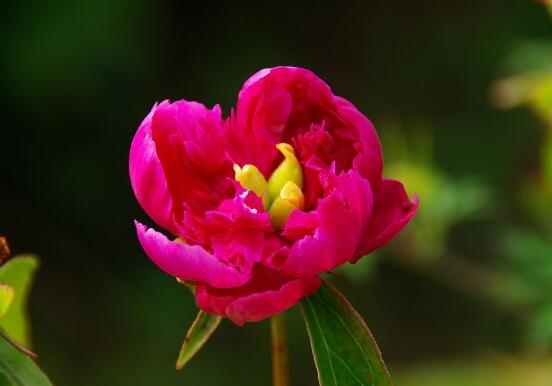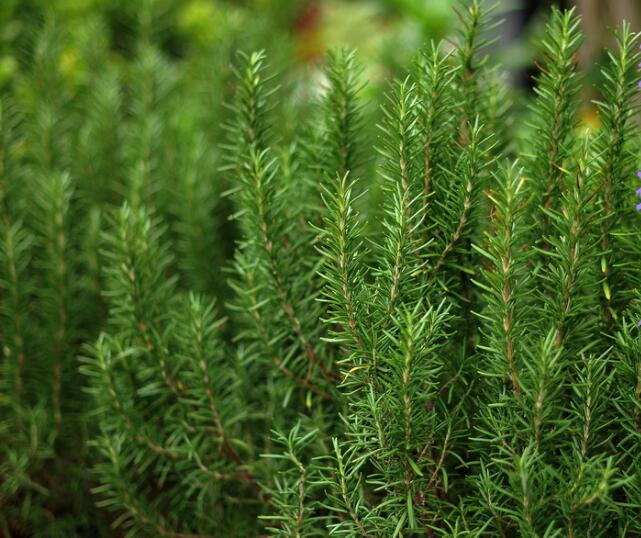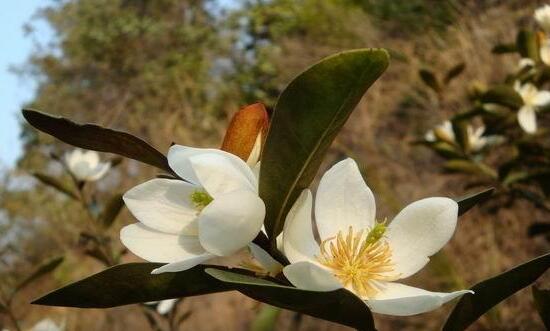How to breed peony flowers, peony flowers three propagation methods/cutting operation is the simplest
About peony flower, flower friends are no stranger, it is a very beautiful flower, in the medicinal treatment has a very good effect. It is also the effect and role of peony flower, many people want to reproduce peony flower, how does peony flower reproduce? After inquiry, there are three main propagation methods of peony flower: cuttage, rationing and sowing. The specific operation will be introduced in detail by Xiaobian.
1. How to breed peony flowers, cutting/dividing plants/sowing

In daily farming, although mastering the breeding method of peony flower is enough, but you want it to change ten pots, increase ornamental, reproduction is what you need to do, then how to reproduce peony flower? Simply put, there are three methods, cuttage, sub-plant and sowing, of which cuttage is the most commonly used, how to do it, we then look down.
Three methods of propagation of peony flower
Cuttings, rationing, seeding
(1)Cuttage propagation of paeonia lactiflora
Because peony is a herb, so its branches growth ability is very strong, it is said that a few branches can reproduce a pot of peony. However, it is simple to say, but we need to work hard on cutting time, substrate and cuttings. The specific operations are as follows:
① Cutting time
The choice of time for flower cuttings is very important. If you want to have a high survival rate of peony cuttings, it is best to choose from April to June, when the plants are in a rapid growth period and full of activity.
② Matrix
Peony flower cuttage, is inserted in the soil, so before cuttage, to choose a good matrix, the best choice vermiculite or perlite, if it is a family pot, with ordinary soil plus river sand can be.
Note: peony flower on the soil requirements are relatively high, so before cutting to disinfect the soil. Disinfection method: Soak the soil in 0.5% potassium permanganate solution, take it out after half an hour, and then dry it in the sun.
③ Cutting selection
The success or failure of peony flower cuttings is closely related to the quality of cuttings. Flower friends can cut shoots 5-8 cm in length from the lower part of the peony shoot node, leaving 2-4 bud eyes and 2-3 leaves as cuttings.
Cutting treatment: After selecting cuttings, we should also put it in clean water for 30-60 minutes, dip it in 0.5% IBA rooting powder, or dip it in 0.010% naphthylacetic acid aqueous solution for 5 seconds, and then carry out cuttage.
④ Cutting begins
After finishing the above work, peony flower cuttings propagation should officially begin. The treated cuttings are inserted into the prepared pot soil to a depth of about 5 cm, and the spacing between cuttings is such that the leaves do not touch each other. After cutting, pour enough water, then cover with plastic film to keep moisture.
5 Maintenance after insertion
After the above steps are completed, the peony flower cuttage propagation is basically completed, and finally only the post-insertion maintenance is left. Flower friends put the flowerpot in an environment with a temperature between 20-25℃ and a humidity of 80%-90%, and it usually takes root within 20-30 days. After rooting, remove the plastic film and reduce the amount of water sprayed and watered. It is worth mentioning that the survival rate of cuttage propagation is high, flower friends can try to see oh ~
(2)Propagation of paeonia lactiflora by plant division
① Time of plant division
Plant division is one of the propagation methods of peony. According to the biological practice of flower friends, the ramet propagation of peony flowers must be carried out in September and October, and a sunny weather should be selected.
② ramet selection
Excavate 2-3 years old peony, shake off the soil, and then put the root tip upward to dry until the rhizome wilts naturally, then divide the plant, use both hands to break apart along the natural gap of the root group, when it is not easy to break, use a knife. It is better to have 3-6 new buds and a certain number of thick roots after division.
③ Start of ramet
After cutting, the wounds should be disinfected with plant ash, and then they should be planted in large earthen pots prepared in advance. All roots should be naturally stretched and watered once after completion. The above is the division and reproduction of peony flowers. Practice has proved that peony must be divided once every 5~6 years. If it is not divided for 10 years, it will bear roots and rot and turn to decline.
(3)Seed propagation method of peony flower
Seeds can be sown, so sowing is also one of the breeding methods of peony flowers, pay attention to the seeds to be taken after sowing. Sowing time, preferably in the white dew before that period of time. Soak seeds in warm boiled water at 50℃ for 24 hours before sowing. After sowing, the seedbed should be watered once, then covered with plastic bags. After sowing, water at any time according to soil moisture content to keep it moist.
How do flowers propagate?
Cuttage propagation is to use the regeneration ability of plant roots, stems, leaves and buds to make it take root and germinate under appropriate conditions to form new plants. The advantages are: maintaining the characteristics of each plant; flowering earlier than seed reproduction; simple reproduction method, convenient materials, high survival rate; conditions can be carried out in all seasons; the species that cannot bear fruit can be propagated by this method. Disadvantages are: cuttage plant roots shallow, shorter growth period. Stem cuttings include hardwood cuttings and soft cuttings.
1. Hardwood cuttage: pomegranate, hibiscus, hibiscus, crape myrtle, winter jasmine, poinsettia and other deciduous flowers and trees use this method. In early spring before sap flow. Select 1~2 years old strong and full branches, select the middle section, cut into 10-15 cm long branches as cuttings, with 2-3 buds, cuttings terminal buds to be full and intact. The upper end is 0.5 - 1 cm above the bud, cut into a flat mouth, the lower end is 0.5 - 1 cm below the bud, cut into an inclined mouth, the bud is on the side of the tip of the inclined mouth, inserted into the cutting substrate, and the depth is 1/2 of the cutting. Hardwood cuttings are most species of sand stored in the winter before winter, spring and then inserted. Some tropical, subtropical flowers and trees can also be cut in advance in the greenhouse.
Cutting propagation of Rosa chinensis
Second, soft branch cutting: greenhouse flowers such as fuchsia, geranium, begonia, etc.; open grass flowers such as a string of red, dahlia, cherry, etc.; evergreen broad-leaved flowers such as jasmine, azalea, laughter, camellia, osmanthus, etc. Use this method. It takes place from late May to September. Select semi-lignified branches with leaves as cuttings, such as semi-lignified branches near the lower end of the tip after flowering. The cuttings are about 6 - 10 cm long, with 2-3 buds, cut as hard branches, and cut off the lower leaves, and the upper leaves can be cut off as appropriate to reduce evaporation. The survival rate of cutting and transplanting was the highest. When cutting poinsettia, geranium, oleander and so on, the incision often flows out a lot of juice, must wait for the incision to dry before inserting, otherwise the incision is easy to rot and survive.
Third, leaf insert: Begonia, chrysanthemum, stone lotus flower, tiger tail orchid and other species that can grow adventitious roots and adventitious buds in veins or petioles can be propagated into new plants by leaf insert. When cutting leaves, keep petioles about 3 cm, and cut off part of thin tender leaf margin, insert petioles into matrix; if there are no petioles, cut them with knife at the intersection of veins, lay leaves on matrix, make them closely contact with matrix, or fix veins in matrix with bamboo sticks, root at veins and grow into new plants. Sanseiberia is fleshy sword-shaped leaf, which can be cut into 5 cm leaf segments for spikelets, inserted directly in the sand, not upside down, new roots can occur at the base to form new plants.
4. Leaf bud insertion: rubber tree, hydrangea, jasmine, hibiscus, etc. When leaf insertion, their petioles and leaf axils can take root, but they cannot germinate, so they cannot grow into new plants. Therefore, it is necessary to select leaf cuttings with an axillary bud at the base to develop into new plants.
V. Root cuttings: flowering crabapple, peony, Lingxiao, kiwi fruit, hypericum, wax plum, perennial phlox, lotus bud peony, etc., flowers with adventitious buds growing on their roots can be propagated by using roots as cuttings. When changing pots of flowers and trees, cut 5-10 cm root sections, insert them directly or obliquely into the soil, do not turn upside down, and the upper end is flat with the soil surface. After new buds grow, cultivate the soil properly.
No matter what kind of cuttage method is adopted, it must be watered after insertion, and then covered with glass or plastic film on the cuttage pot to maintain a certain temperature and humidity, placed in a semi-shady place, strengthened management, and transplanted culture after rooting. In order to make the survival rate of cuttings high, in addition to the selection of cuttings, matrix is also very important, matrix should be well drained, but also have a certain amount of water retention. Vermiculite, pearlite, slag and chaff ash are better cutting substrates. The substrate should be maintained at a temperature above 20℃, i.e., the atmospheric temperature should be above 25 ℃, so that the cutting incision can be easily healed and rooted.
The full range of breeding methods for peony teaches you to reproduce peony correctly.
Peony is a very famous ornamental flower variety, flowers are big and colorful, very eye-catching, many people like to decorate in the home, beautify the home environment, peony is a very popular flower, so cultivation is also more, today Xiaobian to talk to you about the breeding method of peony:
Click here for more pictures.
Breeding methods of peony:
The propagation method of peony: 1. Dividing plants
Plant division method is the most commonly used propagation method of peony, peony production area seedlings production, basic use of this method of reproduction. The method has three advantages: firstly, it blooms earlier than the sowing method, and the seedlings bloom 4 to 5 years later, while the seedlings can bloom every other year; secondly, the operation of plant division is simple and easy, and the management saves labor, which is beneficial to wide application; thirdly, it can maintain the excellent characteristics of the original variety. The disadvantage is that the reproduction coefficient is low, and the three-year-old mother plant can only be divided into 3~5 daughter plants, which is difficult to adapt to and meet the needs of modern large-scale production and the rapidly growing domestic and foreign flower market. This has always been a big problem in the production of peony seedlings.
Breeding method of peony: 2. Sowing method
Seeds should be sown immediately after harvest. With the delay of sowing time, the moisture content and germination rate of seeds decreased. The seed has double dormancy of hypocotyl and epicotyl. The soil temperature in autumn after sowing makes hypocotyl release dormancy and radicle develop and take root. The better the rooting situation in that year, the more vigorous the growth in the next year; if the sowing is too late, the ground temperature cannot release the hypocotyl dormancy and cannot produce very much, the germination rate in the spring of the next year is greatly reduced. After sowing and rooting in autumn, the dormancy of epicotyl can be released after a long period of low temperature in winter. The following spring, when the temperature rises and the humidity is suitable, the embryo is unearthed.
The propagation method of peony: 3. Cutting method
Select a high terrain, good drainage nursery to do cuttage bed, bed soil after loosening, spread 15 cm thick river sand, river sand to use 0.5% potassium permanganate disinfection. Cuttage medium also can use vermiculite or pearlite. Set up a 1.5-meter high awning on the bed. According to the experience of Changchun and other places, the cutting effect is best in mid-July. The cuttings are 10 - 15 cm long. With two nodes, the upper compound leaf, leaving a few leaves; the next compound leaf, including petioles cut off, with a concentration of 500×10~1000×10 naphthylacetic acid or indoleacetic acid solution after rapid dip treatment, insertion depth of about 5 cm, spacing to the leaves do not overlap each other. After inserting, pour water and cover with plastic shed. It was observed that the best rooting effect was obtained when the substrate temperature was 28~30℃ and the humidity was 50%. The temperature of cuttage greenhouse is 20~25℃, humidity is 80%~90%, then 20~30 days after cuttage can take root and form dormant buds. After rooting, water spraying and watering should be reduced, and plastic sheds and awnings should be gradually removed. Cuttings grow slowly and need to overwinter on the bed. In the spring of the following year, they are planted in the open field.
The method of propagation of peony: 4. Root insertion method
The roots of peony are cut off when the plants are divided in autumn, cut into root sections of 5 - 10 cm, inserted into deep and smooth ditches, the depth of the ditches is 10 - 15 cm, the fine soil with thickness of 5 - 10 cm is covered, and water can be poured thoroughly.
Breeding methods of peony: 5. layering method
In spring, the budding sprouts will pass through the pot hole of the flower pot and be introduced into the flower pot with a diameter of 15 - 20 cm. With the growth, the soil will be gradually filled, and the pot soil will be kept moist. In summer, the roots will take root. Before winter, the stems under the pot will be cut off to form a potted peony.
The propagation method of peony: 6. Modern tissue culture method
Plant tissue culture, i.e. aseptic plant culture technology, is based on the theory that plant cells have totipotency, using isolated organs, tissues or cells (such as roots, stems, leaves, etc.) of Paeonia lactiflora to induce callus, adventitious buds, adventitious roots under aseptic and suitable artificial culture medium, light, temperature and other conditions, and finally form complete plants with the same genetic characteristics as maternal plants. This technology is also known as cloning technology, to achieve the purpose of rapid reproduction, has a wide range of application value.
There are six main breeding methods of peony, of which the plant division method is the most commonly used, can maintain the excellent varieties, but also relatively simple, if you want to reproduce peony in furniture, this method is better.
- Prev

Can rosemary be cut? the propagation method of rosemary / can be cut
Rosemary is a kind of plant with a very long history, which existed as early as the Cao Wei period in China, when it was introduced in Europe, and now many plant lovers in China have planted it. Can I cut rosemary? The answer is yes, and it can be not only cuttage, but also striping.
- Next

How to propagate Michelia mollissima, the propagation method of potted Michelia mollissima / cutting propagation is the most practical
For Michelia flowers, flower friends should be no stranger, it has pleasant colors, rich flowers, not only strong ornamental, but also no cosmetic treatment. In the process of breeding, if you want to have more than one pot of Michelia, it is necessary to master the breeding method of Michelia. How can Michelia reproduce?
Related
- Fuxing push coffee new agricultural production and marketing class: lack of small-scale processing plants
- Jujube rice field leisure farm deep ploughing Yilan for five years to create a space for organic food and play
- Nongyu Farm-A trial of organic papaya for brave women with advanced technology
- Four points for attention in the prevention and control of diseases and insect pests of edible fungi
- How to add nutrient solution to Edible Fungi
- Is there any good way to control edible fungus mites?
- Open Inoculation Technology of Edible Fungi
- Is there any clever way to use fertilizer for edible fungus in winter?
- What agents are used to kill the pathogens of edible fungi in the mushroom shed?
- Rapid drying of Edible Fungi

